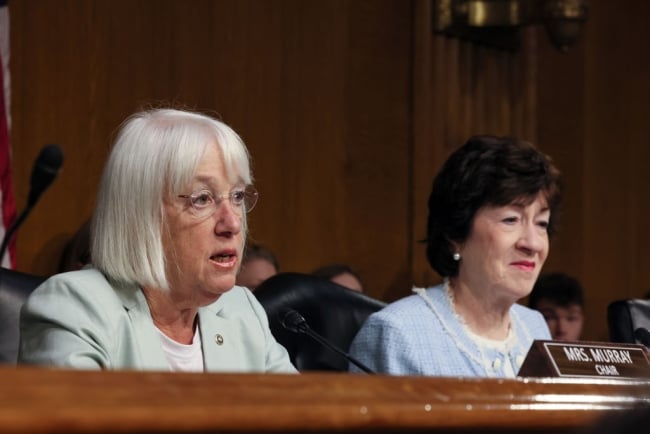You have /5 articles left.
Sign up for a free account or log in.

Washington senator Patty Murray (left), the Democrat who chairs the appropriations committee, said the draft budget that includes money for the Education Department will make Pell Grants go further for students.
Jemal Countess/Stringer/Getty Images Entertainment/Getty Images
Senate appropriators, in drafting the budget for the Education Department and other agencies, say they made the most of a difficult situation to reach a compromise on a bill that can pass both chambers of Congress and be signed into law.
That compromise would give the Education Department about $370 million more in discretionary funds than it received for the current fiscal year, according to a sparse bill summary released ahead of Thursday’s appropriations committee markup. The Senate plan also would increase the maximum Pell Grant award from $7,395 to $7,645 for the 2024–25 academic year.
“We looked hard at every program and worked together to address the highest priority funding needs,” said Wisconsin senator Tammy Baldwin, the top Democrat on the appropriations subcommittee tasked to write the bill for the Education Department and other agencies.
House Republicans are planning deep cuts to the department and other agencies. The draft budget for the Education Department released earlier this month cut billions from the agency—defunding Federal Work-Study and other programs. Higher education associations said they were concerned about those cuts and how they would impact students.
Federal spending on domestic programs will be flat for the upcoming fiscal year as part of a budget deal reached earlier this summer to avert a default on the country’s debt. House Republicans have since planned to make deeper cuts than those called for in the deal, setting up a clash between the two chambers over the budget.
The Senate’s draft spending plan would give the Education Department at least $12 billion more compared to the House Republicans’ version, which hasn’t passed out of the full committee yet. House Republicans are planning to keep the maximum Pell Grant award at $7,395.
Baldwin noted that the bill was developed in a bipartisan manner, which hasn’t been the case in the House.
“The House process threatens a government shutdown and sequestration to defense and nondefense programs,” Baldwin said. “This bill can be passed by the Senate, passed by the House and signed by the president.”
The House and Senate need to pass all 12 appropriations bills before Jan. 1, 2024, in order to avoid a forced 1 percent cut to all agencies under the debt ceiling deal. Following Thursday’s markup, the Senate appropriations committee has moved all 12 bills forward.
Washington senator Patty Murray, the Democrat who chairs the appropriations committee, said this is the first time since 2018 that the Senate has marked up all 12 bills. The bills have passed with overwhelming, bipartisan support.
“It is not mission accomplished,” she said in her closing remarks at the markup. “As we all know, we still have to get these bills passed through the full Senate and the House and signed into law, and I know that all of us are going to work really hard to get that done. But this is a really big deal.”
More Money for NIH, Other Programs
The full committee voted 26 to 2 to favorably report the Labor, Health and Human Services, Education, and Related Agencies appropriation bill. The overall budget has less money than the current fiscal year, though it includes a number of increases. For example, the National Institutes of Health would get $943 million more for fiscal year 2024. The agency received $43 billion in the current fiscal year.
The appropriations committee said in a news release that the Labor-HHS budget would “provide additional funding for Federal Student Aid to support student borrowers, implement more affordable payment options, and address longstanding issues in student loan forgiveness programs.” The committee did not release specific budget numbers ahead of the markup.
The bill would give $15 million more to the Teacher Quality Partnership program—up from $70 million in fiscal year 2023—and keep funding flat at $15 million for the Hawkins Centers of Excellence in order to address the shortage of teachers, according to the summary. Additionally, the budget would maintain the funding levels for other programs such as TRIO and GEAR UP, which are aimed at helping low-income students access and complete college.
“It’s a difficult endeavor in any year to put this bill together, but this year, the bill was even harder to write because of the cuts Congress agreed to in order to not default on our debt and crash our economy,” Baldwin said.
West Virginia senator Shelley Moore Capito, the top Republican on the appropriations subcommittee, said this is the first time since 2017 that the committee has had to reduce spending on multiple programs.
“This has been a difficult exercise for us, but I think we’ve come up with a very good solution,” she said.
Emmanual Guillory, senior director of government relations at the American Council on Education, said he was happy to at least see an increase in the Pell Grant given the fiscal constraints Congress is under.
However, he’s concerned about the programs cut in the House’s budget that weren’t not mentioned in the committee’s initial summary, such as Federal Work-Study.
“We remain concerned about the programs that weren’t spoken of,” he said, adding that ACE won’t support the elimination of programs.
For fiscal year 2024, he said the goal is to keep funding level with the current fiscal year, though ideally ACE would like to see a greater investment in the department’s programs.
“If we get more, then that’s a win in this sort of budgetary cap environment,” he said.




